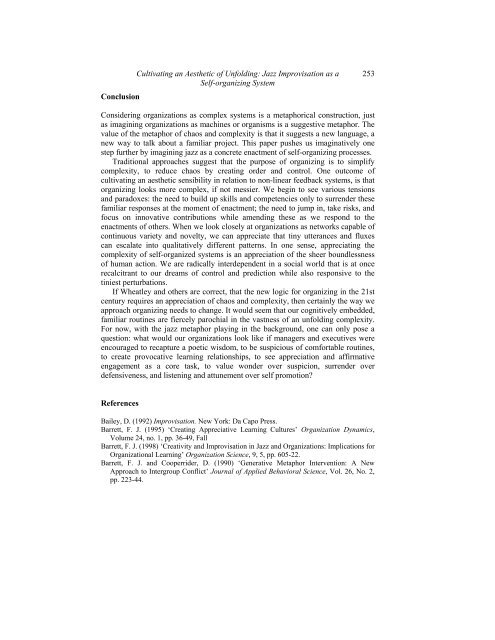Cultivating aesthetics - iSites
Cultivating aesthetics - iSites
Cultivating aesthetics - iSites
You also want an ePaper? Increase the reach of your titles
YUMPU automatically turns print PDFs into web optimized ePapers that Google loves.
Conclusion<br />
<strong>Cultivating</strong> an Aesthetic of Unfolding: Jazz Improvisation as a<br />
Self-organizing System<br />
253<br />
Considering organizations as complex systems is a metaphorical construction, just<br />
as imagining organizations as machines or organisms is a suggestive metaphor. The<br />
value of the metaphor of chaos and complexity is that it suggests a new language, a<br />
new way to talk about a familiar project. This paper pushes us imaginatively one<br />
step further by imagining jazz as a concrete enactment of self-organizing processes.<br />
Traditional approaches suggest that the purpose of organizing is to simplify<br />
complexity, to reduce chaos by creating order and control. One outcome of<br />
cultivating an aesthetic sensibility in relation to non-linear feedback systems, is that<br />
organizing looks more complex, if not messier. We begin to see various tensions<br />
and paradoxes: the need to build up skills and competencies only to surrender these<br />
familiar responses at the moment of enactment; the need to jump in, take risks, and<br />
focus on innovative contributions while amending these as we respond to the<br />
enactments of others. When we look closely at organizations as networks capable of<br />
continuous variety and novelty, we can appreciate that tiny utterances and fluxes<br />
can escalate into qualitatively different patterns. In one sense, appreciating the<br />
complexity of self-organized systems is an appreciation of the sheer boundlessness<br />
of human action. We are radically interdependent in a social world that is at once<br />
recalcitrant to our dreams of control and prediction while also responsive to the<br />
tiniest perturbations.<br />
If Wheatley and others are correct, that the new logic for organizing in the 21st<br />
century requires an appreciation of chaos and complexity, then certainly the way we<br />
approach organizing needs to change. It would seem that our cognitively embedded,<br />
familiar routines are fiercely parochial in the vastness of an unfolding complexity.<br />
For now, with the jazz metaphor playing in the background, one can only pose a<br />
question: what would our organizations look like if managers and executives were<br />
encouraged to recapture a poetic wisdom, to be suspicious of comfortable routines,<br />
to create provocative learning relationships, to see appreciation and affirmative<br />
engagement as a core task, to value wonder over suspicion, surrender over<br />
defensiveness, and listening and attunement over self promotion?<br />
References<br />
Bailey, D. (1992) Improvisation. New York: Da Capo Press.<br />
Barrett, F. J. (1995) ‘Creating Appreciative Learning Cultures’ Organization Dynamics,<br />
Volume 24, no. 1, pp. 36-49, Fall<br />
Barrett, F. J. (1998) ‘Creativity and Improvisation in Jazz and Organizations: Implications for<br />
Organizational Learning’ Organization Science, 9, 5, pp. 605-22.<br />
Barrett, F. J. and Cooperrider, D. (1990) ‘Generative Metaphor Intervention: A New<br />
Approach to Intergroup Conflict’ Journal of Applied Behavioral Science, Vol. 26, No. 2,<br />
pp. 223-44.
















